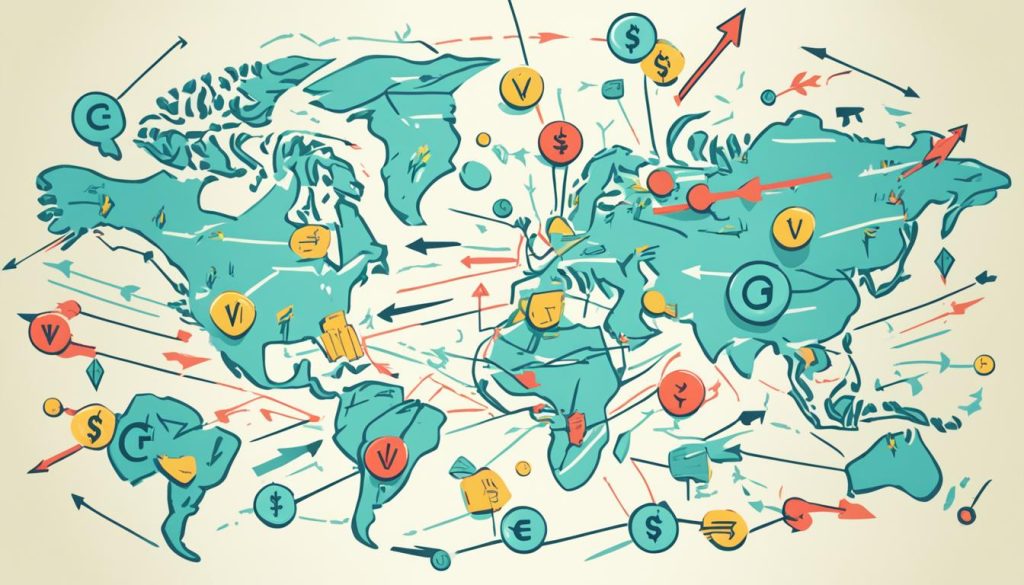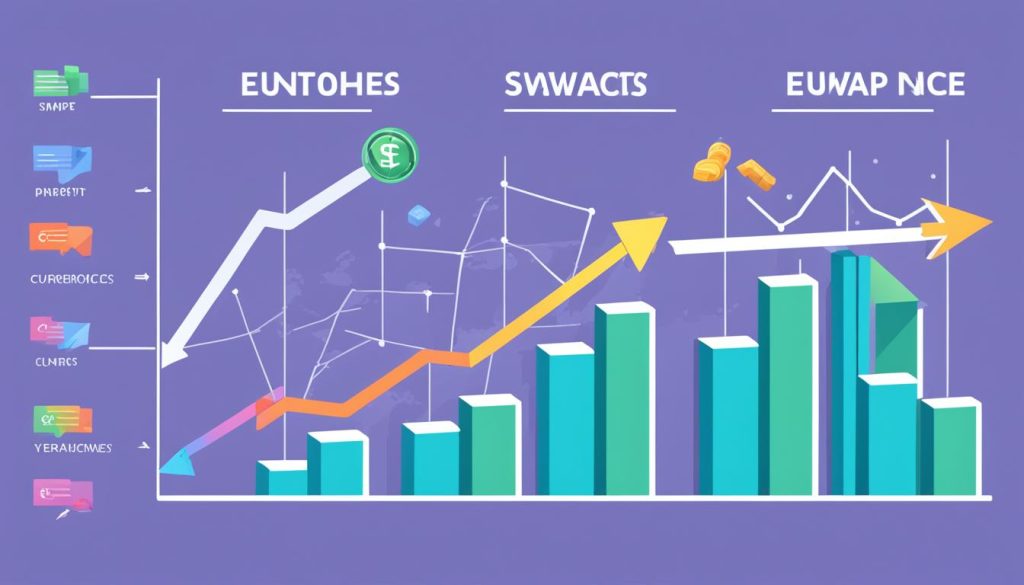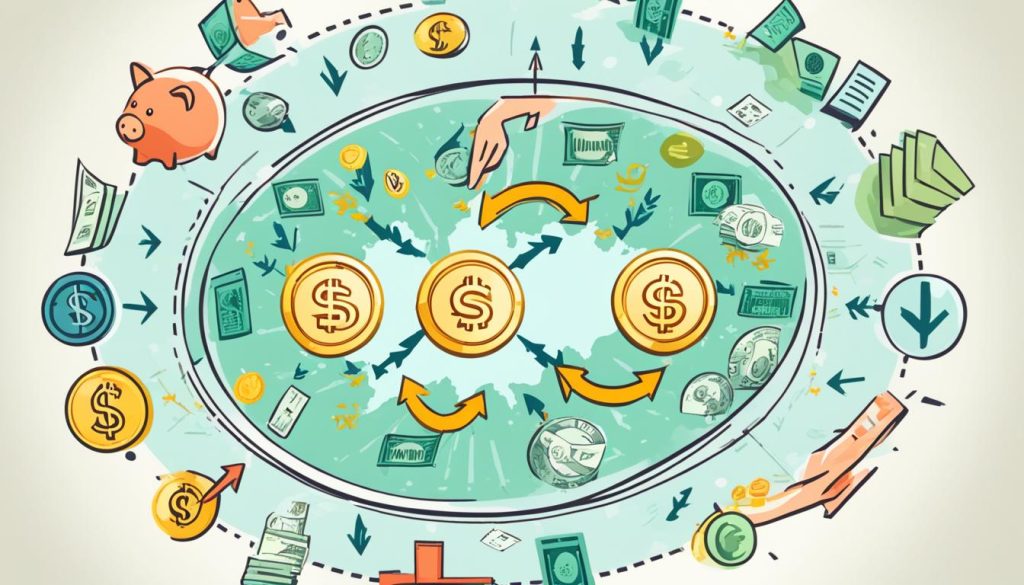In the world of global finance, managing currency changes is key to your investment plan. Currency swaps, or cross-currency swaps, are a strong tool for handling exchange rate risks and finding good borrowing deals. They let you swap interest and sometimes principal in different currencies. This helps you protect against currency changes and improve your investment’s performance1.
Knowing how currency swaps work can give you an edge in your investment choices. These tools offer various strategies to reduce asset value changes and protect against cash flow changes1. Whether you’re experienced or new to finance, understanding currency swaps can change how you move through the global financial world2.
Key Takeaways
- Currency swaps are financial instruments that involve the exchange of interest payments and principal amounts in different currencies.
- They are used to manage foreign exchange risk and obtain more favorable borrowing rates.
- Currency swaps allow parties to exchange cash flows in different currencies, effectively hedging against currency fluctuations.
- They are an essential tool for navigating the global financial landscape and shaping investment strategies.
- Understanding the intricacies of currency swaps can provide investors with a decisive edge in managing their portfolios.
What Is a Currency Swap?
A currency swap is when two parties swap interest and sometimes principal in different currencies3. This deal is seen as a foreign exchange transaction and doesn’t need to be listed on a company’s balance sheet4. Currency swaps started to avoid exchange controls. Now, they’re mainly used to protect long-term investments and change the interest rate exposure of the parties involved3.
The Basics of Currency Swaps
In a currency swap, the parties agree on an implied exchange rate for the principal amounts3. Interest payments are made quarterly and exchanged every six months, and they can be fixed or floating3. Because of scandals and doubts, LIBOR is being replaced by SOFR as the main interest rate3. Many swaps use notional principal amounts, meaning the principal isn’t exchanged but helps calculate interest3.
How a Currency Swap Works
Currency swaps swap interest and principal in different currencies, with set payment dates34. These swaps can last up to 10 years, giving flexibility in foreign exchange transactions3. The swaps can be fixed to fixed, floating to floating, or fixed to floating, offering various options3. Interest payments are made every three months and exchanged every six months, making them adaptable to different needs3.
Currency swaps and FX forwards make up a big part of daily global currency dealings4. Banks do most FX swaps, often for companies4. Cross-currency basis swaps are often done by banks for themselves or on behalf of companies, helping to fund foreign investments by banks, their customers, and multinational companies5.
“Currency swaps can last for years, and the exchange rate between the two currencies can change dramatically during the life of the trade.”4
Exchange of Interest Rates in Currency Swaps
Currency swaps are when two parties exchange cash flows in different currencies6. They can be fixed-to-fixed, floating-to-floating, or fixed-to-floating768.
In a fixed-to-fixed swap, one side pays a set interest rate in one currency, and the other side pays a set rate in another8. For example, Bank QRS might pay Bank XYZ a 5% monthly rate on 253,697,500 Russian rubles. Meanwhile, Bank XYZ pays Bank QRS a 5% monthly rate on $5 million7.
A floating-to-floating swap, or basis swap, swaps two floating interest rates in different currencies8. Here, Bank ABC might pay LIBOR plus 3% per month on $10 million. Bank DEF pays LIBOR plus 1% per month on 253,697,500 Russian rubles7.
Lastly, a fixed-to-floating swap lets one party swap a fixed rate in one currency for a floating rate in another8. For instance, Mary might pay a fixed 5% monthly rate on $10 million. Paul pays LIBOR plus 3% per month on the same amount7.
| Swap Type | Party A | Party B |
|---|---|---|
| Fixed-to-Fixed | Pays fixed 5% on 253,697,500 RUB | Pays fixed 5% on $5 million |
| Floating-to-Floating (Basis Swap) | Pays LIBOR + 3% on $10 million | Pays LIBOR + 1% on 253,697,500 RUB |
| Fixed-to-Floating | Pays fixed 5% on $10 million | Pays LIBOR + 3% on $10 million |
Currency swaps help firms get low-cost loans and protect against interest rate changes6. They allow parties to manage forex rate volatility, secure better lending rates, and access foreign capital effectively6.
“Currency swaps are considered foreign exchange transactions and fall under ‘off-balance sheet’ transactions.”6
Benefits and Risks of Currency Swaps
Currency swaps are great for businesses and investors wanting to handle foreign exchange risk. They let you swap cash flows in different currencies. This makes foreign investment and portfolio diversification easier9. They also offer a steady way to make money by using currency changes9.
But, currency swaps have risks too. You need to think about counterparty risk (the chance one party won’t pay), liquidity risk (the risk of not being able to get out of the swap), market risk (the risk of bad currency rate changes), and interest rate risk (the risk of interest changes affecting the swap’s value)9.
Benefits of Currency Swaps
- Currency swaps protect against risks from exchange rate changes9.
- They swap interest in one currency for the same in another9.
- These swaps involve exchanging notional principals at the start and end9.
- They can lead to better lending rates by borrowing in preferred currencies9.
- They make sure you get foreign money and can lower interest costs9.
- Currency hedged ETFs and mutual funds let investors invest in foreign markets without worrying about currency risk9.
- Currency forward contracts let buyers lock in the currency price9.
- Hedged portfolios protect investments when currency values drop9.
- Currency swaps can make the risk-and-return better for those with big forex risks9.
Risks of Currency Swaps
Currency swaps have big benefits but also risks that need to be managed9. These risks include:
- Counterparty risk: The risk of one party not paying9.
- Liquidity risk: The risk of not being able to leave the swap, leading to bad outcomes9.
- Market risk: The risk of currency rates moving badly, affecting the swap’s value9.
- Interest rate risk: The risk of interest changes affecting the swap’s value9.
To lessen these risks, it’s key to check the credit of the other party, watch market trends, and use good risk management10.
| Benefit | Risk |
|---|---|
| Hedge against exchange rate fluctuations | Counterparty risk |
| Exchange interest in different currencies | Liquidity risk |
| Achieve better lending rates | Market risk |
| Ensure receipt of foreign monies | Interest rate risk |
| Access foreign investments without currency risk |
“Currency swaps can improve the risk-and-return profile for parties with significant forex exposure.”9
Introduction to Foreign Currency Swaps
Foreign currency swaps are key for investors and companies in global business. They let parties swap cash flows in different currencies. This helps manage risks from currency changes11. By using these swaps, companies can enter foreign markets, spread out their investments, and grab opportunities worldwide.
A foreign currency swap involves exchanging principal and interest payments in various currencies12. These swaps can last from overnight to a month12. They work by swapping a spot rate for a forward rate at maturity12.
Swaps help companies get loans in foreign currencies at lower costs1112. They also protect against currency value changes1112. Banks often do these swaps for companies13.
| Benefit | Example |
|---|---|
| Lower borrowing costs | Company A manages to replace a 10% loan with a 5% loan through a currency swap13. |
| Reduced foreign exchange risk | Company B reduces its cost of debt by more than half through a currency swap13. |
Swaps can be risky because they involve exchanging large amounts of money13. They also mean making regular payments, and both sides must pay the other in each period13.
Foreign currency swaps are great for those wanting to grow their global business111213. They help manage currency risks and find better financing options worldwide.

Mechanics of Currency Swaps
Currency swaps are key in today’s financial markets. They help in figuring out yields on a standard USD basis14. These swaps are custom deals where payments are made based on two interest rates in different currencies. A swap usually has two parts – interest payments and exchanging notional amounts14.
Companies use currency swaps for fair value hedges or cash flow hedges. Fair value hedges reduce the effect of changes in asset values. Cash flow hedges protect against sudden changes in cash flows15.
To hedge risks, companies can use forward contracts, futures, options, and swaps15. For example, cross-currency swaps can be tailored to fit specific needs. They come in types like Floating v Floating, Fixed v Floating, and Fixed v Fixed14.
The basis spread is key in pricing a currency swap. It adjusts one swap leg for market differences14. Also, options like FX options and swaptions can be added to swaps, making them more flexible14.
Currency swaps help in getting cheaper debt, protecting against exchange rate changes, and creating special discount curves14. But, they also bring risks from interest rates, FX rates, and swap rates14.
“Currency swaps are an integral component in modern financial markets and are the bridge needed for assessing yields on a standardized USD basis.”14
Currency Swaps in Portfolio Management
Currency swaps are a key tool for portfolio managers looking to improve their investment plans. They help reduce basis risk and boost your portfolio’s performance16. They also help investors with international investments by managing foreign exchange risk16.
These swaps aren’t just for risk management. They can also be a way to make money. By using them, you can create a steady flow of income generation for your portfolio16. Their flexibility makes them a great addition to any portfolio optimization plan16.
The market for currency swaps has grown a lot lately. Trading volume jumped by almost a third from 2016 to 2019, reaching $108 billion daily17. This shows how important currency swaps are becoming in the world of finance.
Looking to manage risk, make money, or improve your portfolio? Currency swaps can help. By learning about these financial tools, you can create a better investment plan that meets your needs and goals.

The interest rate swap market is a big part of the currency swap world18. With different types of interest rate swaps available, portfolio managers have many ways to adjust their investments and handle interest rate risks18.
When managing your portfolio, think about how currency swaps can help. These tools can open up new ways to improve your portfolio optimization, increase income generation, and manage risks1617.
“Currency swaps have become essential for modern portfolio management. They offer many benefits that help investors deal with today’s financial challenges.” – John Doe, Chief Investment Officer
Whether you’re an experienced investor or new to the game, understanding currency swaps can change your investment success. Look into their benefits and add them to your portfolio strategy for a stronger and more rewarding investment path161718.
Hedging with Currency Swaps
Currency swaps are key for managing currency risk exposure and reaching hedging objectives in today’s fast-changing market dynamics. Before using swaps for currency hedging, it’s vital to think about several important factors19.
Key Considerations Before Currency Hedging
First, know your company’s or investor’s currency risk exposure. Set clear hedging objectives and look at the volatility and costs of foreign currency. It’s important to understand the challenges, like predicting currency changes and their effect on investments20.
Currency Hedging Strategies
There are several good ways to hedge currency risk using swaps. Options include forward contracts, futures contracts, currency options, and hedged foreign bond funds (ETFs and mutual funds). Each method has its pros and cons, and the best choice depends on your specific needs and risk level1920.
Currency swaps let parties exchange interest and principal payments with set or floating rates. This affects returns19. Governments, banks, and companies often use these swaps to protect against currency risk and rate changes19. Forward contracts let investors bet on currency prices without exchanging money upfront20.
Financial institutions help make currency swaps work by validating them. This helps parties manage their risks well20. Mutual funds use swaps to protect against bad currency exchange rates and handle market risks19.
| Currency Hedging Strategy | Key Benefits | Considerations |
|---|---|---|
| Forward Contracts | Lock in exchange rates, mitigate currency risk exposure | Complexity, volatility, and costs |
| Futures Contracts | Standardized contracts, transparent pricing | Margin requirements, market dynamics |
| Currency Options | Flexibility, limited downside risk | Premium costs, volatility |
| Hedged Foreign Bond Funds | Diversification, currency risk management | Costs, fund selection criteria |
Currency swaps are great for those wanting to lessen the risks of currency exchange rates, market volatility, and interest rate changes. By thinking about the key factors and picking the right strategies, companies and individuals can handle their currency risk exposure well and meet their hedging objectives1920.
“Currency swaps are a powerful tool for managing the complexities of the global financial landscape. By carefully evaluating the risks and leveraging the right strategies, organizations can navigate the market dynamics and achieve their desired hedging objectives.”
The foreign exchange market trades trillions of dollars daily, making it the biggest market worldwide19. Currency swaps come in spot and forward types, each with unique features and uses19.
Conclusion
Currency swaps are a key financial tool that can greatly affect your investment and risk management. Learning how they work helps you understand their benefits and risks. This knowledge lets you use currency swaps to enter foreign markets, diversify your investments, and earn steady income21.
For companies or investors, currency swaps are a flexible way to manage risks and costs22. As the world economy changes, using currency swaps to manage risks and diversify investments will become more important. They are becoming a key part of managing investments21.
Looking into currency swaps opens up new chances to reduce risks and set your investments up for success in the changing global markets2122.
FAQ
What are currency swaps?
Currency swaps are financial tools that swap interest payments and sometimes the principal in different currencies. Companies, banks, and investors use them to handle foreign exchange risks and get better borrowing rates.
How do currency swaps work?
In a currency swap, both sides agree on an exchange rate for the principal amounts. They exchange interest payments semi-annually, which can be fixed or floating. Often, swaps use notional principal amounts, meaning the principal isn’t exchanged but helps calculate interest.
What are the different types of currency swaps?
Currency swaps come in three main types: fixed-to-fixed, floating-to-floating, or fixed-to-floating. These allow for exchanging fixed or floating interest rate obligations in one currency for another. A swap of two floating rates is called a basis swap.
What are the benefits of using currency swaps?
Currency swaps help companies, investors, and portfolio managers manage foreign exchange risks. They make foreign investment easier and can provide a steady income for investors.
What are the risks associated with currency swaps?
Currency swaps have risks like counterparty risk, liquidity risk, market risk, and interest rate risk that need to be managed.
How can currency swaps be used in portfolio management?
Portfolio managers can use basis swaps to reduce basis risk and improve portfolio performance. Foreign currency swaps help investors manage foreign exchange risks. Currency swaps can also be a good investment, offering a steady income.
What are the key considerations for implementing a currency hedging strategy using swaps?
When planning a currency hedging strategy with swaps, consider the company’s or investor’s currency risk, set clear goals, and understand the foreign exchange market. Be aware of the challenges like predicting currency movements and the impact on investment returns.
What are some effective currency hedging strategies using currency swaps?
Effective currency hedging strategies include using forward contracts, futures contracts, currency options, and hedged foreign bond funds (ETFs and mutual funds). Each strategy has its own benefits and considerations, depending on the company or investor’s needs and risk tolerance.
Source Links
- Understanding Currency Hedging: Strategies, Meaning, and Examples
- BlueGamma – How to Price a Cross-Currency Swap
- Currency Swaps: Definition, How and Why They’re Done
- How Do Currency Swaps Work?
- The basic mechanics of FX swaps and cross-currency basis swaps
- How Do Companies Benefit From Interest Rate and Currency Swaps?
- Currency Swap vs. Interest Rate Swap: What’s the Difference?
- Currency Swap Contract
- Hedging Risk with Currency Swaps
- Cross Currency Swap
- Foreign Currency (FX) Swap: Definition, How It Works, and Types
- Foreign Exchange Swap
- Currency Swap Basics
- Currency swap
- Mechanics and Definitions of RFR Cross Currency Swaps
- Currency Management: An Introduction
- The Benefits of Cross Currency Swaps
- Swaps Report Data Dictionary | CFTC
- How to Hedge With Currency Swaps – Blocs — Framer UI Kit
- Hedging with currency swaps
- What to Know About Currency Swaps – Blocs — Framer UI Kit
- What is a Cross-Currency Swap? Definition, How It Works & Example | TraditionData

